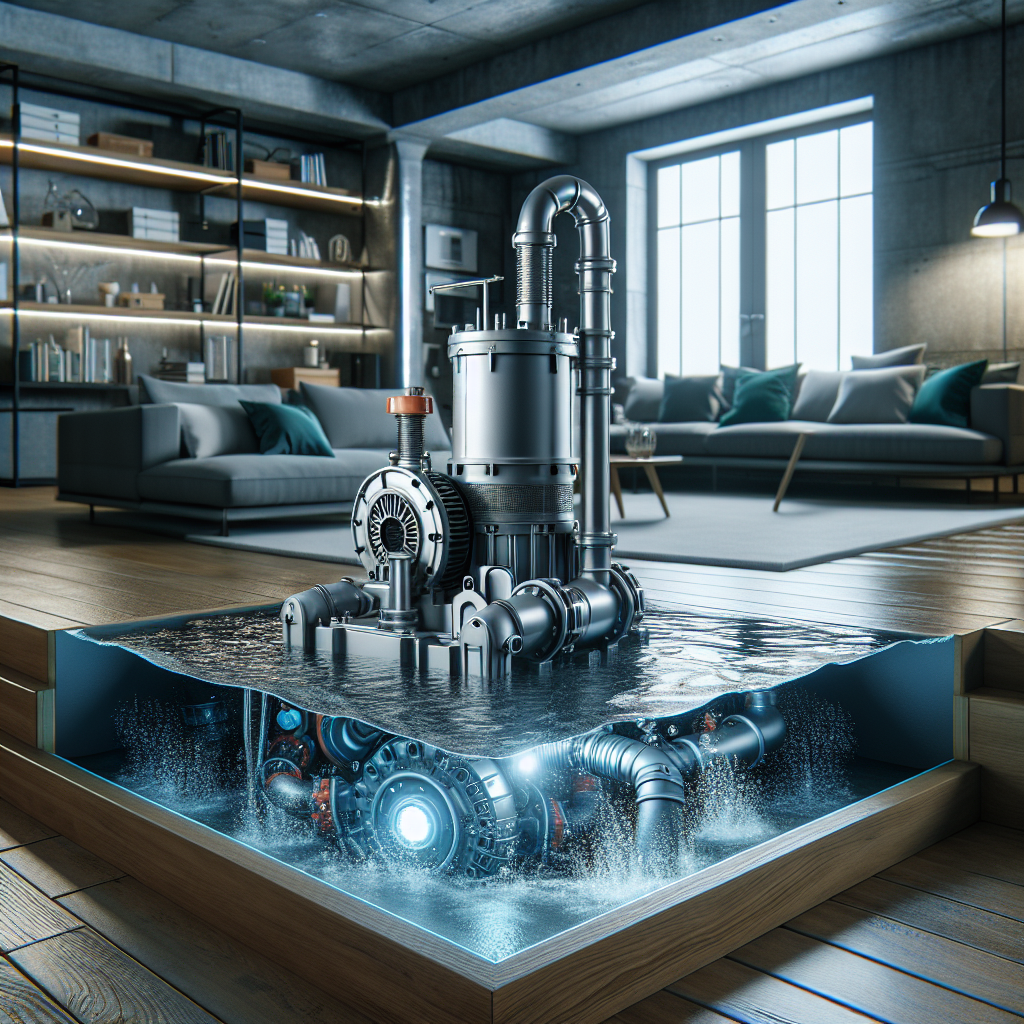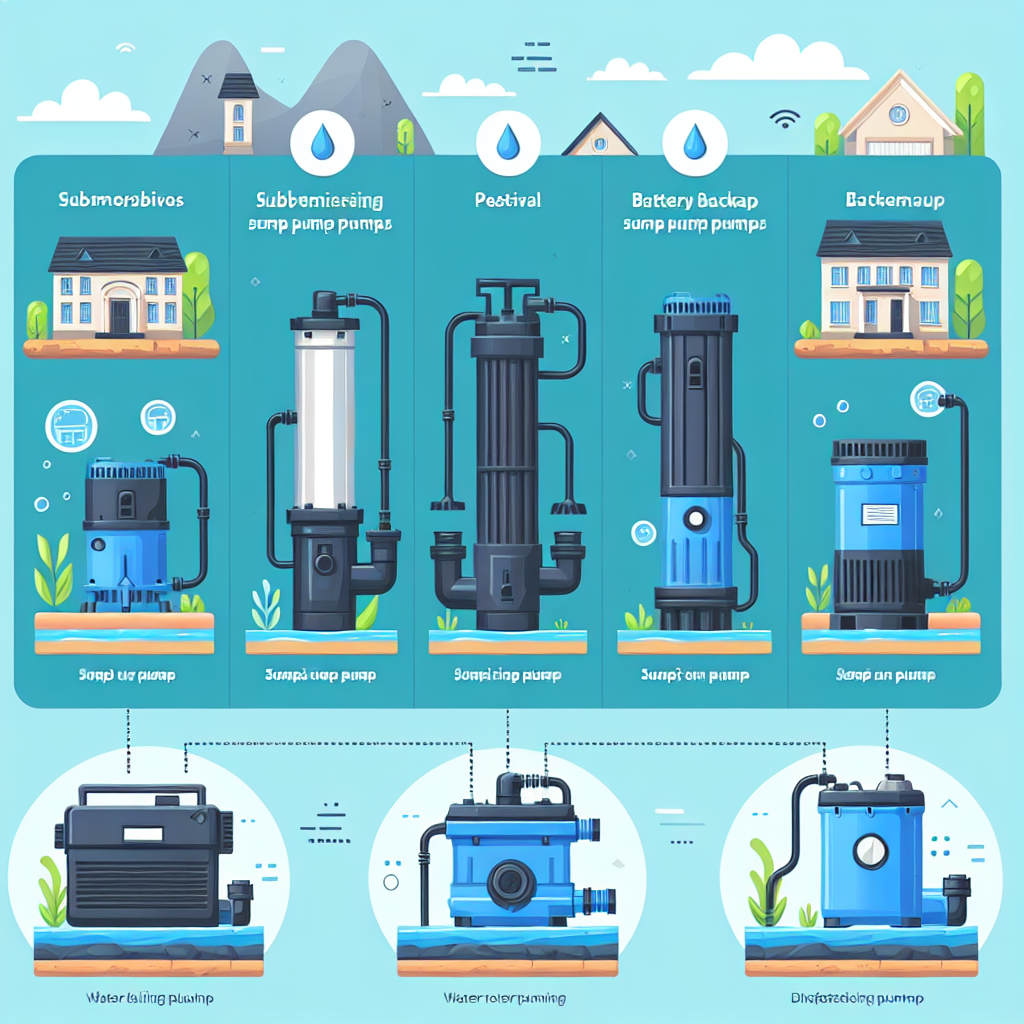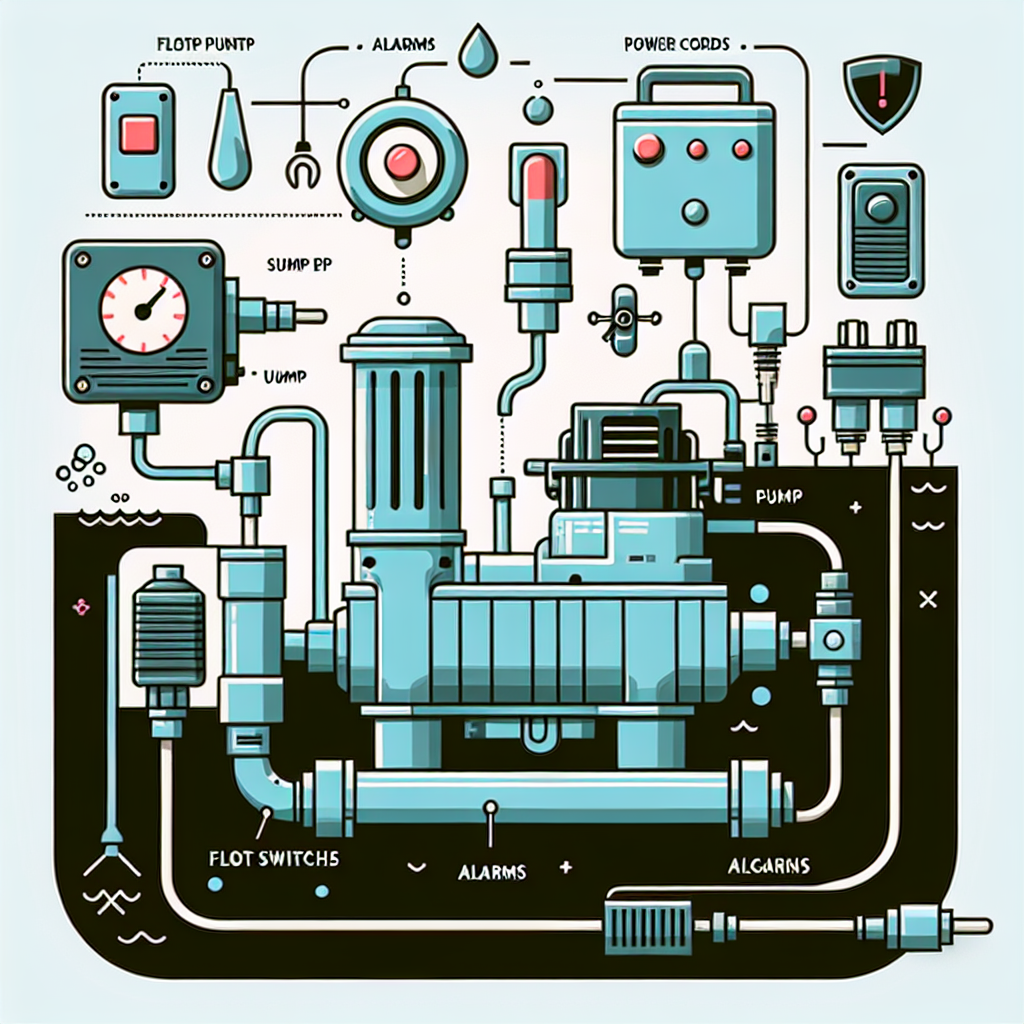Ultimate Guide: Choosing the Perfect Sump Pump for Your Home
Introduction to Sump Pumps
Definition of a sump pump
A sump pump is a hero in disguise, lurking in the depths of your sump pit, ready to tackle the pesky problem of basement flooding. This nifty device is designed to remove excess water from your home, ensuring that your basement or crawl space remains dry and cozy. Think of it as the bouncer at a club-keeping unwanted water out and letting only the good vibes in.
Importance of sump pumps in home maintenance
If you’ve ever experienced the horror of basement flooding, you know just how crucial a sump pump can be. These devices are essential for maintaining a healthy home environment, especially if you live in an area prone to heavy rains or snowmelt. Here’s why they matter:
- Water Damage Prevention: A reliable sump pump helps prevent costly water damage by directing excess water away from your foundation.
- Crawl Space Management: For homes with crawl spaces, a crawl space sump pump is vital for controlling moisture and preventing mold growth.
- Increased Home Value: Homes equipped with effective flood control systems often have higher resale values, as buyers appreciate the peace of mind that comes with proper waterproofing.
- Insurance Benefits: Many homeowners insurance policies cover sump pump failure leading to water damage, making them a smart investment.
Key Takeaway: Investing in a good quality sump pump is like buying insurance for your basement-better safe than sorry!
Common problems addressed by sump pumps
Sump pumps are not just about keeping things dry; they also tackle several common issues faced by homeowners:
- Poor Water Drainage: If your yard has poor drainage or if you live in a low-lying area, a sump pump can help redirect water away from your home.
- Mold and Mildew Growth: Excess moisture leads to mold, which can impact air quality and health. A functioning sump pump keeps humidity levels low.
- Sump Pump Failure: Regular sump pump maintenance is crucial. A backup sump pump or battery backup for sump pumps can be lifesavers during power outages or system failures.
- Noisy Operation: Some homeowners experience noisy pumps. Choosing a quiet operation sump pump, like submersible models, can enhance comfort.
The right sump pump installation, whether it’s a submersible or pedestal model, will depend on your specific needs and space constraints. Understanding these common problems will guide you toward selecting the perfect system for effective flood control.
If you’re considering DIY options for sump pump installation, remember that professional help might save you time and headaches down the line-unless you’re feeling particularly adventurous!

The bottom line? Sump pumps are more than just gadgets; they’re essential tools for safeguarding your home against water damage. So grab your cape (or maybe just some tools) and get ready to embrace this unsung hero of home maintenance!
Your next step? Dive deeper into our guide to find out which type of sump pump suits your needs best!
Types of Sump Pumps
Submersible Sump Pumps
Let’s start with the rock stars of the sump pump world: submersible pumps. These little wonders are designed to sit directly in your sump pit, working tirelessly to keep your basement dry. Think of them as the ultimate undersea warriors, diving deep into water to expel it efficiently.
One major advantage is their quiet operation. Unlike their pedestal counterparts, submersible pumps are submerged in water, which dampens noise and allows for a more peaceful home environment. Plus, they typically have a higher capacity for handling large volumes of water, making them ideal for homes prone to serious flooding.
- Advantages:
- High capacity for water drainage.
- Quiet operation.
- Space-saving design.
- Considerations:
- More complex installation may require professional help.
- Regular maintenance is crucial to ensure longevity.
Pedestal Sump Pumps
If submersible pumps are the cool kids on the block, then pedestal sump pumps are their reliable friends. These pumps sit above the sump pit and use a long pipe to draw water up from below. They’re great for those who want easy access for maintenance and repairs-no diving into murky waters required!
The pedestal design also allows for better airflow around the motor, which can lead to a longer lifespan. However, they can be slightly noisier due to their above-water operation. If you’re dealing with minor moisture issues rather than full-blown flooding, this could be an energy-efficient option worth considering.
- Advantages:
- Easier access for maintenance and repairs.
- Tend to have a longer lifespan due to better airflow.
- Cost-effective compared to submersible options.
- Considerations:
- Noisier operation compared to submersible models.
- Lesser capacity might not suffice in extreme flooding situations.
Battery Backup Sump Pumps
No one likes surprises-especially when it comes to power outages during heavy rains! That’s where battery backup sump pumps come in clutch. These systems kick in when your primary pump fails or when the power goes out, ensuring that your basement remains dry even during emergencies!
Key Takeaway: Investing in a battery backup system is like having an insurance policy against unexpected disasters-better safe than sorry!
This type of pump can be paired with either submersible or pedestal models and is essential for anyone serious about water damage prevention. Just imagine: while storms rage outside, you’re sipping coffee inside without a care in the world because you’ve got backup!
- Advantages:
- Keeps working during power outages.
- Adds an extra layer of protection against flooding.
Water-Powered Sump Pumps
If you’re looking for something that’s both eco-friendly and efficient, meet the water-powered sump pump. These clever devices use municipal water pressure instead of electricity or batteries. They’re perfect if you live in an area where power outages are common or if you want an energy-efficient solution that doesn’t rely on electricity at all!
The downside? They require a constant supply of water pressure and may not be suitable if you have low municipal pressure. But if you’ve got good city water pressure flowing through your pipes, this could be a game-changer!
- Advantages:
- No electricity needed; runs on municipal water pressure.
- Energizes your flood control system sustainably!
- Considerations:
- Might not work well with low city water pressure systems.

Your choice among these types depends on your specific needs and circumstances! Remember that proper sump pump maintenance, regardless of type, is key to keeping these devices running smoothly. So whether you’re gearing up for DIY sump pump installation or calling in the pros, make sure you’ve got the right tool for the job!
Your next step? Explore our guide further to find out which type fits seamlessly into your home’s unique needs!
Key Factors to Consider When Choosing a Sump Pump
Pumping Capacity and Flow Rate
When it comes to sump pumps, pumping capacity and flow rate are your best friends. Think of them as the horsepower under the hood of your car. You want a pump that can handle the volume of water that could potentially flood your basement.
Flow rate is typically measured in gallons per hour (GPH). For residential needs, a pump with at least 2,000 GPH is ideal for handling heavy rains or snowmelt. If you live in an area prone to basement flooding, consider a high capacity sump pump that can manage larger volumes.
Key Takeaway: Choose a sump pump with a flow rate that exceeds your maximum expected water influx during storms!
Sump Pit Size and Depth
The size of your sump pit is crucial when selecting a sump pump. A larger pit allows for more water storage before the pump kicks in, which is essential for effective flood control. Ideally, your sump pit should be at least 24 inches deep.
If you have limited space, don’t worry! Many sump pumps are designed to fit snugly into smaller pits without sacrificing performance. Just ensure that whatever model you choose can effectively clear out the volume of water expected.
- Considerations:
- A deeper pit allows for better drainage and less frequent pumping.
- A wider pit can accommodate higher flow rates and larger pumps.
Power Source (Electric vs. Battery)
Your choice between electric and battery-powered sump pumps can make or break your flood control system. An electric pump is usually more powerful and efficient, but what happens when the power goes out during a storm? Cue the dramatic music!
This is where battery backup systems come into play. They provide peace of mind by ensuring that even during outages, you’re covered against unexpected flooding. A combination of both systems offers the best protection-think Batman and Robin fighting against water damage!
- Advantages:
- Electric pumps: Higher power output.
- Battery backup: Ensures operation during outages.
- Considerations:
- A battery backup requires regular maintenance to ensure it’s ready when needed.
Noise Level Considerations
If you’re sensitive to noise (or just enjoy quiet evenings), consider the noise level of your chosen sump pump. Generally, submersible pumps are quieter than their pedestal counterparts because they operate underwater. However, if you’re opting for a pedestal model due to accessibility or budget constraints, expect some noise during operation.
Key Takeaway: If noise levels are a concern, go submersible for a peaceful home environment!
Durability and Build Quality
Your sump pump will face some tough conditions-think moisture, mud, and occasional debris! Therefore, durability should be at the top of your list when choosing one. Look for models made from high-quality materials like cast iron or thermoplastic that can withstand wear and tear over time.
- Considerations:
- A good warranty often indicates quality craftsmanship; don’t skip this detail!
The last thing you want is to deal with sump pump repair due to poor build quality right when you need it most! So invest wisely in something built to last-your future self will thank you!

Your next step? Armed with this knowledge about key factors in selecting your perfect sump pump, dive into our comprehensive guide on specific models that suit your needs best!
Sump Pump Features and Technologies
Automatic vs. Manual Operation
When it comes to sump pumps, one of the first decisions you’ll face is whether to go for an automatic sump pump or a manual one. Think of automatic pumps as the overachievers in the class-they kick into action at the first sign of trouble, keeping your basement dry without you lifting a finger. Manual pumps, on the other hand, are like that friend who only shows up when you call them-reliable but requiring a bit more effort on your part.
Advantages of Automatic Sump Pumps:
- Hands-free operation-no need to remember to turn it on.
- Better for busy households or those prone to sudden storms.
- Integrated float switches ensure they activate at the right water level.
Considerations for Manual Pumps:
- You must monitor water levels and operate them manually.
- Can be less expensive upfront but may lead to more hassle during emergencies.
Float Switch Types and Functionality
The float switch is like the brain of your sump pump, determining when it should spring into action. There are several types of float switches, each with its unique quirks:
| Float Switch Type | Description |
|---|---|
| Vertical Float Switch | Moves up and down as water levels change; great for tight spaces. |
| Tethered Float Switch | A floating ball attached to a cord; allows for more movement but needs space. |
| Differential Float Switch | A two-float system that prevents rapid cycling and improves efficiency. |
Selecting the right float switch can significantly affect your pump’s performance and longevity. A well-functioning float switch means fewer headaches during heavy rainstorms!
Alarms and Monitoring Systems
If you want peace of mind while you’re away from home, consider adding alarms or smart monitoring systems to your sump pump installation. These nifty gadgets can alert you via text or app notifications if something goes awry-like if your pump fails or if water levels rise too high. It’s like having a personal assistant watching over your basement!
Key Takeaway: Investing in alarm systems enhances water damage prevention, ensuring you’re always in the loop!
- Main Benefits:
- Immediate alerts help prevent potential disasters.
- You can monitor performance remotely, which is perfect for vacationers!
- Adds an extra layer of security to your flood control system.
A smart sump pump monitor could be just what you need to keep calm during storm season!
Cord Length and Power Requirements
The length of the power cord on your sump pump might seem trivial, but it can make all the difference during installation! A longer cord offers flexibility in placement, allowing you to position your pump where it’s most effective without straining connections. However, make sure that whatever outlet you’re using meets the power requirements-nobody wants their flood control system shutting down due to inadequate power supply!
- Pumping Efficiency Considerations:
- Your sump pump should ideally be plugged directly into a wall outlet; avoid using extension cords whenever possible.
- If using an extension cord is unavoidable, ensure it’s rated for heavy-duty use to prevent overheating or malfunctioning.

Your choice in cord length and power source plays a significant role in ensuring optimal functionality for your sump pump system! So pay attention during installation-it’s worth it!
Your next step? Now that you’re armed with knowledge about essential features and technologies in sump pumps, explore our guide further to find out which specific model fits seamlessly into your home’s unique needs!
Sump Pump Installation Process
Selecting the Right Location for Installation
Choosing the perfect spot for your sump pump installation is like finding the right seat at a concert: you want to be close enough to see the action but not so close that you get drenched in sweat (or water, in this case). Ideally, your sump pump should be located in the lowest part of your basement or crawl space, where water naturally collects. Here are some tips to keep in mind:
- Ensure the area is accessible for maintenance and repairs.
- Avoid placing it near walls where water might pool from outside drainage issues.
- Consider proximity to power sources without risking electrical hazards.
Your goal? A location that maximizes efficiency while minimizing headaches down the line!
Preparing the Site for Installation
Once you’ve selected the ideal location, it’s time to roll up your sleeves and prep that site! This step is crucial for ensuring your sump pump operates effectively. Here’s how to get started:
- Clear Out Debris: Remove any dirt, rocks, or clutter from the area. You want a clean slate for your flood-fighting hero!
- Create a Sump Pit: Dig a hole approximately 24 inches deep and 18 inches wide. This will be your sump pit, where all the magic happens.
- Add Gravel: Place about 6 inches of gravel at the bottom of the pit to help with drainage and support.
- Check Drainage Systems: Ensure any existing water drainage systems are functioning properly before proceeding.
A little prep work goes a long way in preventing future mishaps!
Step-by-Step Installation Guide (if DIY)
If you’re feeling adventurous and want to tackle this as a DIY sump pump installation, here’s a handy step-by-step guide:
- Install the Sump Pump: Place your chosen sump pump into the pit. Ensure it sits level and stable on top of the gravel.
- Add PVC Pipe: Connect PVC piping from the pump discharge outlet to direct water away from your home. Make sure it slopes away from your foundation!
- Add Check Valve: Install a check valve on top of the discharge pipe to prevent backflow into your sump pit.
- Create an Electrical Connection: Plug in your pump according to manufacturer instructions-make sure it’s grounded properly!
- Test Your Pump: Pour some water into the pit and watch as your new hero springs into action. Ensure it pumps out efficiently without leaks.
If all goes well, you’ve just become an honorary member of Team Sump Pump! But remember, if you hit any snags along the way, don’t hesitate to call in reinforcements (a professional plumber).
When to Hire a Professional Plumber
If DIY isn’t quite your style or if you’re feeling overwhelmed by any part of this process, hiring a professional plumber might be wise! Here are some scenarios when it’s better left to experts:
- If you’re unsure about local building codes and permits required for installation.
- If electrical work is involved beyond simple plug-in connections-better safe than sorry!
- If you’re dealing with complicated drainage issues or existing plumbing systems that need integration with your new sump pump.
Key Takeaway: Don’t hesitate to call in professionals if you’re facing complexities; they can save you time and ensure everything runs smoothly!
Your next step? Whether you’re tackling this project solo or enlisting help, understanding these steps will set you up for success in keeping that basement dry!
Sump Pump Maintenance Tips
Regular Inspection Checklist
Just like you wouldn’t skip your annual check-up at the doctor, your sump pump deserves some love too! Regular inspections can help catch issues before they turn into full-blown emergencies. Here’s a handy checklist to keep your pump in tip-top shape:
- Check the power source: Ensure your pump is plugged in and that the outlet is functioning.
- Inspect the float switch: Make sure it moves freely without obstruction.
- Examine the discharge pipe: Look for clogs or leaks that could hinder performance.
- Test the pump: Pour water into the sump pit to see if it activates properly.
- Look for signs of wear: Check for rust or corrosion on metal components.
Key Takeaway: Regular inspections can save you from unexpected water disasters-make it a routine!
Cleaning the Sump Pit and Pump Components
A clean sump pit is a happy sump pit! Over time, dirt, debris, and even little critters can accumulate in your sump pit. Here’s how to keep things spick and span:
- Turn off power: Safety first! Unplug your sump pump before cleaning.
- Remove debris: Use a wet/dry vacuum to suck up mud, leaves, and other gunk from the pit.
- Clean the pump: Wipe down the exterior of your pump with a damp cloth. For deeper cleaning, refer to manufacturer instructions.
- Add fresh gravel: If you notice sediment buildup at the bottom of the pit, replace or add gravel to enhance drainage.
If you’re not comfortable doing this yourself, consider hiring a pro for thorough cleaning-it might be worth every penny!
Troubleshooting Common Issues
If your sump pump starts acting up like a moody teenager, don’t panic! Here are some common issues you might encounter and how to troubleshoot them:
- Pump won’t turn on: Check if it’s plugged in and ensure that the float switch isn’t stuck. If it’s still silent, there may be an electrical issue.
- Pump runs continuously: This could indicate a faulty float switch or an issue with drainage. Make sure there’s no blockage in the discharge line!
- No water being pumped out: Check for clogs in both the intake screen and discharge pipe. A little maintenance here can go a long way!
- Pumping noise is excessive: If it sounds like a jet engine taking off, inspect for any loose parts or debris inside that could cause rattling.
If troubleshooting doesn’t solve these problems quickly, don’t hesitate to call for sump pump repair. It’s better to nip potential issues in the bud than deal with basement flooding later!
Your Next Step: Keep this guide handy for quick reference during maintenance sessions. A well-maintained sump pump is key to effective water damage prevention.
Your sump pump is like that reliable friend who always shows up when needed-keep it healthy so it can keep your basement dry!
Sump Pump Regulations and Codes in Lehigh Valley Area
Permits Required for Installation
When it comes to sump pump installation in the Lehigh Valley area, navigating the local regulations is crucial. Just like you wouldn’t build a treehouse without checking for zoning laws, you don’t want to install a sump pump without the proper permits! Most municipalities require permits to ensure that installations comply with safety standards and building codes. Here’s what you need to know:
- Check Local Codes: Each municipality may have different requirements. Contact your local building department for specifics.
- Permit Application: You’ll likely need to fill out a permit application that details your intended installation.
- Inspections: After installation, an inspection may be required to ensure everything is up to code.
Skipping these steps could lead to fines or having to redo your work, which is about as fun as watching paint dry!
Best Practices for Compliance
Once you’ve got your permits squared away, it’s time to focus on best practices for compliance. Think of these as the golden rules of sump pump installation that keep you on the right side of the law (and dry in your basement):
- Follow Manufacturer Guidelines: Always adhere to the manufacturer’s installation instructions. They know their product best!
- Use Licensed Professionals: If you’re unsure, hiring a licensed plumber can help ensure compliance with local codes and reduce headaches down the line.
- Avoid DIY Pitfalls: While DIY sump pump installation might sound appealing, improper installation can lead to costly repairs and potential flooding-definitely not what you want!
- Keep Documentation: Maintain records of all permits, inspections, and maintenance performed on your sump pump system. This can be helpful if any issues arise later.
Your Next Step: Understanding and following local regulations not only keeps your home safe but also enhances its value. A compliant sump pump system is a happy sump pump system!
The bottom line? Compliance with sump pump regulations in Lehigh Valley isn’t just about avoiding fines; it’s about ensuring that your home remains protected from water damage while giving you peace of mind during those stormy nights!
Conclusion
Recap of Importance of Choosing the Right Sump Pump
Choosing the right sump pump is like picking the perfect superhero for your home’s flood control system. These devices are essential for preventing basement flooding, protecting your property from water damage, and maintaining a dry and healthy living environment. A well-chosen pump can save you from costly repairs, mold growth, and that dreaded musty smell that comes with moisture. Remember, not all sump pumps are created equal-understanding your specific needs is key!
Final Recommendations for Homeowners
As you embark on your sump pump journey, here are a few final recommendations:
- Assess Your Needs: Consider factors like your basement size, local climate, and potential water influx to determine the right type and capacity.
- Invest in Quality: Opt for energy-efficient sump pumps with a good warranty to ensure longevity and reliability.
- Regular Maintenance: Schedule routine checks to keep your pump in tip-top shape-think of it as giving your home’s hero a little TLC!
- Consider Backup Options: A battery backup for sump pump or an emergency sump pump system can provide peace of mind during unexpected power outages.
Your Next Step: Take action today! Evaluate your current setup and consider upgrading or installing a new system if needed. Your dry basement will thank you!
Encouragement to Consult Professionals for Guidance
If you’re feeling overwhelmed or unsure about which sump pump installation is right for you, don’t hesitate to reach out to professionals. A licensed plumber can provide invaluable insights tailored to your specific situation, ensuring that you make informed decisions that align with local regulations and best practices. Plus, they can handle any tricky installations or repairs that might pop up along the way!
The bottom line? Investing in expert advice not only simplifies the process but also enhances the effectiveness of your flood control measures. So whether you’re tackling this project solo or calling in reinforcements, remember: a dry basement is a happy basement!



Leave A Comment